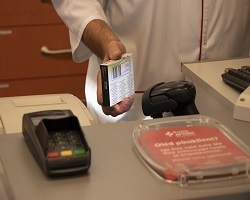Estonia: making medicines affordable and accessible for all

WHO/Gerli Sirk
Tiiu, who lives in southern Estonia, takes care of her husband Wiktor, who needs different medications to treat his cardiovascular disease, diabetes and psoriasis. Both Tiiu and Wiktor are pensioners and had previously considered the out-of-pocket costs for their medicines to be high, despite a subsidy from the government and being eligible for additional reimbursement owing to Wiktor’s high prescription costs. While possibly being entitled to an additional reimbursement for years, Tiiu and Wiktor were unaware of this, so never applied.
“Last year, it was such a pleasant surprise when I went to collect the repeat prescriptions at the pharmacy and the pharmacist informed me that because the cumulative amount of co-payments I had paid so far this year exceeded €100, I now had to pay much less than I thought. The new mechanism makes it very convenient and simple,” said Tiiu.
All patients in Estonia expect to make a co-payment towards their prescriptions at pharmacies. However, before 2018, the system left some of the poorest and oldest people in the population having to pay significant amounts to obtain the medicines they needed. An overly bureaucratic system for reimbursement compounded the issue as many decided not to claim reimbursements they were entitled to.
A people-centred approach
This all changed in 2018, when the government introduced a more people-centred approach that makes paying for prescriptions simpler and cheaper for the patient. Affordability – ensuring people can access health services without suffering financial hardship – is a crucial aspect of universal health coverage (UHC). Today in Estonia, all patients can benefit from a seamless and more protective payment system for prescribed medicines. When their spending on prescriptions in 1 year exceeds €100, the government immediately covers half of any further costs until patients have paid €300 in total, after which the government pays almost all (90%) of any further costs. Unlike the previous system, patients do not have to apply for this benefit and wait to be reimbursed, it happens automatically through the pharmacy’s information technology system.
Out-of-pocket payments for prescription medicines have significantly declined thanks to the improved system, and the figures speak for themselves. In 2017, only 3000 people benefited from additional reimbursement; however, this rose to 134 000 in 2018. The number of people spending more than €250 annually on outpatient prescriptions fell from 24 000 in 2017 (2.8% of the population) to 1000 in 2018 (0.1%).
“In the past, getting the additional reimbursement depended on the patient’s awareness and ability to apply for it. The current system is much fairer. The benefit is calculated automatically and the person does not have to pay significant amounts of money out of pocket to get the medicines they need,” said Riina Sikkut, former Minister of Health and Labour in Estonia.
Making medicines affordable
The new process has transformed how people in Estonia access prescribed medicines, and is a good example of how progressive steps really do help a country to move towards UHC. Medical practitioners easily recognise the difference it can make to people’s health and well-being.
“It is a really positive step. On the one hand, there’s a direct impact by reducing spending on medicines for patients, which leads to better adherence and reduces the risk of adverse events. On the other hand, the automatic nature of the benefit is positive, especially considering the age of the main target group,” said Diana Ingerainen, a general practitioner from Tallinn, Estonia.
Step change for UHC
Although Estonia’s intention was to ensure affordable access to medicines, the previous system was failing those who needed it most. WHO has worked with the Government of Estonia to help influence and ensure a smooth transformation process.
In 2010, the Health Insurance Fund and the Ministry of Health and Labour asked WHO to do an analysis of the financial sustainability of the Estonian health system. WHO interviewed 28 different health stakeholders to see how they understood the system’s sustainability and values, and what they thought should be protected in the health system. Findings showed that financial protection for households was lacking and needed to improve.
A more recent WHO analysis found that the extent of financial hardship in Estonia was high compared to many other European Union countries. This was mainly driven by people having to pay out of pocket for outpatient medicines. Over a period of years, WHO has gently advocated a fairer co-payment system that puts the patient’s perspective at the centre of the transformation and encourages step-by-step progress towards UHC. The government understood that something needed to change and in 2018 took the lead to establish an improved co-payment system.
The improvements are in line with the Tallinn Charter: Health Systems for Health and Wealth, a powerful statement signed in 2008 by all Member States of the WHO European Region, WHO/Europe and other development partners. It promotes equity, solidarity, financial protection and health through health system performance monitoring, assessment and improvement.
The experience of Estonia and other countries – documented in a new WHO study, “Can people afford to pay for health care? New evidence on financial protection in Europe” – demonstrates that although co-payments can cause financial hardship, especially for poor people, it is possible to make medicines more accessible and affordable for everyone.



